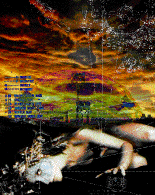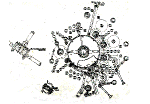
“Primordial Fear”
35 x 28 inches (89 x 71 cm)
© Dorothy Simpson Krause 1999
The image, “Primordial Fear”, was composed from six scanned objects: a photograph by Viola Kaumlen of a dramatic sky; a diagram of Babbage’s computing engine; an early transistor; a photograph by Jan Doucette of model Linda Serafin; a drawing of celestial alignments at Stonehenge; and a compass.
In the screen shot above, the final image and all of the layers that were composited to create it are visible. For the lenticular image, the sky became the deep background and Babbage’s engine a mid background. The transistor rose and set behind the woman who, frozen with fear, did not move. The compass became a mask. The lines of the azmuth and one circle from the Babbage diagram came forward in the picture plane.
To make an object recede in space it is moved in small increments to the left. To make an object come forward it is moved in small increments to the right. The greater the increment and the larger the number of steps, the more depth is created. Eight steps or frames were saved as Tif files.





The eight frames were interlaced together in vertical strips using the software program Flip! The interlaced image was printed on the Roland Hi Fi Jet on Roland PETG white film. Using a CODA laminator, the print was laminated to a plastic 40 lpi lenticular lens from MicroLens. As you move by the image, you see one frame at a time, which creates the illusion of depth and movement.
Primordial Fear was also used to make a hand-pulled print for a USF exchange portfolio, HomeoStatic, “the dynamic equilibrium of man and technology in the digital age”, organized by Brad Shanks. The Photoshop layers were flattened and the resulting image was sized to 15″ x 11″, flipped horizontally and printed on the Roland HI Fi Jet on domestic PETG white film. A sheet of handmade lama-li paper from Nepal was misted and blotted. The print was centered on the paper face down and transferred using the CODA laminator as a monoprint press. When the white film was pulled from the damp paper, the image remained. The transferred print, encapsulated in ink jet receiver, sits on the surface of the paper similar to an emulsion transfer. The 20″ x 16″ digital transfer print is an edition of 34 with 6 artist proofs.





Dorothy Simpson Krause • 800 Lakeside Circle #605, Pompano Beach, FL 33060 • 781 424 5276 • DotKrause@DotKrause.com